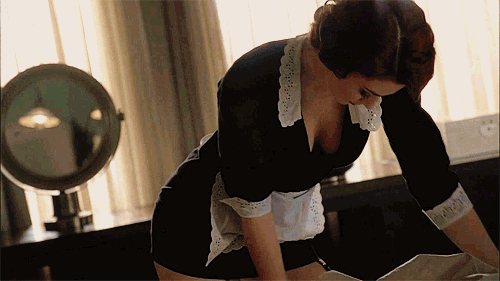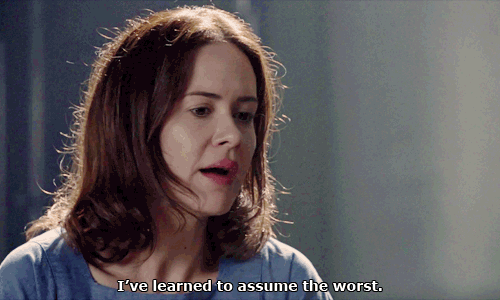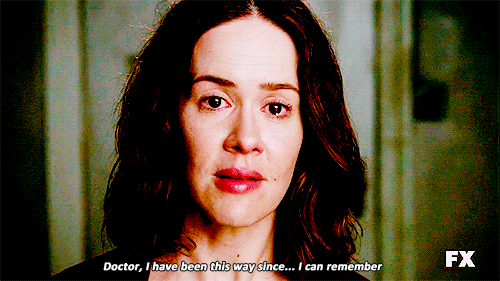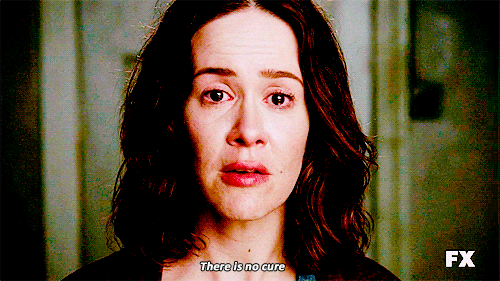
The Lesbians of American Horror Story: For Us, The Scary Parts Are Real
I watched the first season of American Horror Story with giddy abandon. I’m a fan of the horror genre’s ability to subvert certain themes and deal with subjects that other genres do not, and I was excited by what I saw. Tropes were played out, familiar elements were gutted or bloated to the point of camp, and it was beautiful in a gory, ridiculous way. Everyone was eerily gorgeous, and nothing hurt. Actually, a lot of it looked very painful, but you know, horror. Also, things like this happened:
You’re welcome. Anyway.
If you continued watching until the finale, you know that the show took an express train to What-In-The-Fuck-Is-Going-On-Ville towards the end of the season. I don’t want to spoil anyone who hasn’t finished, but let’s just say that the finale left us in a place where it would be impossible to continue the storyline with the same set of characters. When the show was renewed for a second season, I was confused as to who would be populating the narrative. Cue the show’s new premise that the series will move locations and characters with each season as a way of more thoroughly exploring horror tropes. Awesome!
This season takes place in an asylum, which horror fans know as a favorite backdrop for super creepy narratives. The fictional Briarcliff is famous because in the 1960s, it was home to a famous serial killer named Bloody Face. Bloody Face is a real charmer who likes to skin women and use their inside-out flesh to make masks and household items. You know, just normal everyday stuff. Briarcliff is also host to mutant flesheaters, conniving nuns, aliens, and even Anne Frank. Despite what sounds like an open call for a hilariously bad slasher film, the most horrifying part of the show is what “sane” humans are capable of doing to each other in the name of medicine and morality. While some of the residents are clearly disturbed, others are prey to the disturbing mental health treatments that were considered completely acceptable as recently as the 1980s. Housewives were committed by bored husbands, women were committed for being sexually active, and of course, homosexuals were committed for deviant sexuality. Enter the lesbians.
If you’ve read any of my other media opinions, you know I will watch pretty much anything that has lesbians in it, including toothpaste commercials in languages that I don’t understand. It’s a treat for me when the aforementioned content is not terrible, so it’s been a treat to have lesbians on a show I was going to watch anyway.
Briarcliff’s resident lesbian is Lana Winters, played by Sarah Paulson, who is gay in real life! In case my exclamation point wasn’t a tip-off, this is a huge deal. The fact that they cast an actual queer person to play a queer character is something we very rarely see in television and film, so this is a refreshing step in the right direction. Secondly, Lana’s partner is played by Clea Duvall, a Lesbian Household Name. They are equally adorable and gay in real life, in case you were wondering.
After witnessing Glee, I would probably prefer wrestling a rhino to allowing Ryan Murphy anywhere near lesbian narratives again, so my expectations for any portrayal of the lady-loving ladies is pretty low. When I see Ryan Murphy’s name attached to something, I take it as a warning sign that I will probably be offended and/or angered by its contents.
This show has turned out to be a pleasant surprise in those regards, if only because the lesbian narrative has become a sort of queered version of horror that is specific to the gay experience. The horrors that Lana and her partner undergo come as a result of their sexuality, and those horrors are, for the most part, historically accurate.
Lana Winters first arrives at Briarcliff not as a resident but as a journalist looking to uncover the less savory practices of the asylum. Since it’s the 1960s and they both have careers that would be particularly unfriendly to their sexualities, Lana and her partner Wendy, a schoolteacher, are living as “roommates” in order to keep their identities safe. When Sister Jude finds out that Lana has been snooping, she blackmails Wendy into committing Lana to Briarcliff. It’s a sad nod to the conditions of our recent past that the risk of being outed to the community was that dangerous.
At Briarcliff, Lana undergoes a series of horrifying treatments for her “deviant sexuality.” The aversion therapy is particularly disturbing. Lana is hooked up to a vomit-inducing serum while being shown pictures of sexualized women, and then forced to masturbate while touching a naked man. It’s an extremely hard thing to watch, especially when you realize that it’s almost identical to actual medically santioned practices for “curing” homosexuality.
What is so difficult and simultaneously interesting about this narrative is that it is not a far-fetched horror story. It is drawn directly from the actual experiences of homosexuals in the not-so-distant past, painting a realistic picture of a highly homophobic society and the high stakes of living such an environment produces. This is the worst nightmare of a queer person: betrayed by the person they love in an environment where their love is already shamed, told their sexuality is a sin and disease, forced through a series of horrifying cures for said disease, and have society sanction this as medically and morally appropriate. It’s our worst nightmare because we know it was a very real possibility as of forty years ago, and that it’s a level of persecution many of our fellow queer people are still experiencing today. We are still murdered, assaulted, and tortured for our identities. To have such practices fully supported by society is a horror story we don’t need to call inventive or fantastic, because we know the line between our stories and a story like Lana Winters is still too thin.
I don’t want to give too much away, but the conditions have gotten much, much worse for Lana. I will be frank: in comparison to most television shows, the violence is brutal and often sexualized. There are times when I have to turn it off or skip ahead because this season is triggering in a way that even last season didn’t touch, and I’m absolutely terrified for where Lana’s story is going. I’m not actually sure if I will be able to watch for much longer because the sexual violence has become so much more intense in the last few episodes, and I can already see that it’s going to continue to heighten from here on out. If you’re not a fan of the horror genre, or if you find sexualized violence (I say sexualized because not only is there sexual violence, but brutality and gore are sometimes eroticized here in a way you might be familiar with if you’ve seen enough horror) triggering, I would stay away for now. And for queer audiences, we have the added element of horror in knowing that cinematics and staging aside, none of these horrors are really too far-fetched.





